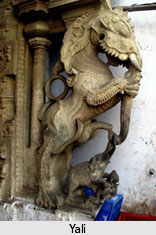 Types of South Indian Temple Sculpture can be defined from the art, sculpture and architecture of Chalukyas, Pandya Dynasty, Chola Dynasty and Pallava Dynasty.
Types of South Indian Temple Sculpture can be defined from the art, sculpture and architecture of Chalukyas, Pandya Dynasty, Chola Dynasty and Pallava Dynasty.
Temple Sculptures from 7th Century
Dravidian style of architecture or southern style has a pyramid shaped tower. It was consisting of progressively smaller storeys of small pavilions, a narrow throat, and a dome on the top called a "Shikhara". The repeated storeys give a horizontal visual thrust to the southern style. Here are the different types of temple sculptures.
Kirtimukha
Kirtimukha is the name of a swallowing fierce monster face with huge fangs, and gaping mouth, quite common in the iconography of Indian and Southeast Asian temple architecture. The word "mukha" in Sanskrit language refers to the "face" while "kirti" means "fame", "glory". Kirtimukha has its origin in a legend from the Skanda Purana when Jalandhara, an all-devouring monster created from Shiva"s third eye willingly ate his body starting by its tail as per Lord Shiva`s order, who pleased with the result gave it the name face of glory.
Kirtimukha as a Motif
Kirtimukha is often used as a decorative motif surmounting the pinnacle of a temple or the image of a deity, especially in South Indian architecture. This face is sometimes assimilated to or confused with another sculptural element, the lion face. However, in order to be a Kirtimukha, it has to be engaged in swallowing, for the Kirtimukha is the figure of the "all consuming". This grotesque face with bulging eyes sits also as an embellishment over the lintel of the gate to the inner sanctum in many Hindu temples signifying the re-absorption that marks the entry into the temple. Mostly it is only a face, although in some places its arms are portrayed as well.
Musical Sculptures of South India
South Indian Temple sculpture has a unique feature which is known as the "musical sculptures". South India is well known for its temples and the rare and interesting stone sculptures of it. Most of these sculptures are found in mainly Tamil Nadu. These musical sculptures are made up of granite architectural elements such as stairways and pillars that produce resonant sounds or music when struck. Hence, these are called "musical sculptures". In a village named Kodumbalur, which lies 25 miles from the town of Pudukkottai in Tamil Nadu, one of the earliest extant examples of such a musical sculpture was recovered. This belongs to the early 10th century AD. This musical sculpture of South India is a grayish stone sculpture of a standing Goddess, probably Parvati, the spouse of Lord Shiva. 
Saptamatrika Sculptures of South India
"Saptamatrika Sculptures" are the unique feature of South Indian temple architecture. "Saptamatrikas" are said to be the energies or shaktis of the deities of the Hindu pantheon like Lord Brahma, Lord Mahesvara, Lord Kumara, Lord Vishnu, Lord Varaha, Lord Indra and Lord Yama. The Saptamatrikas was a very important religious group in India, especially in South India. Hence, they were called Brahmani, Maheshvari, Kaumari, Vasishnavi, Varahi, Indrani and Chamunda. Some of the sculptures of Saptamatrikas can be seen adorned in the walls and some are seen in actual worship form. All these goddesses are sculpted according to the codes of the Agamas.
Animal Motifs in South Indian Sculpture
Another important feature in Dravidian concept is the South Indian Sculpture. The South Indian history has seen a lot of great kingdoms since its beginning, in the Sangam era to around 200 BC. Most of these rulers had contributed in making the art, architecture and sculpture of South India richer. The architects of both Hindu and Jain temples of South India had an innate desire to create animal and bird motifs in their architectural structures.
Depiction of Snakes and Elephants
Pallava Empire showed the depiction of snakes and elephants. One of the best examples of the Pallava Empire depicting the snakes and elephants is the sculpture representing the `Arjuna`s self-punishment` at Mamallapuram. All these motifs feature a very important design element of the architecture of Pallava Era.
Motif of Swan
There is a motif that was widely prevalent in Pallava Era was the motifs of swan. The motif of swan shows the "hamsa" or the swan that has the skill to extract milk from a mixture of milk and water. Swan acts as the symbol for the great sages, who are praised for their purity, who could distinguish the highest truth from worldly reality.
Yali
Yali is a motif in South Indian art and architecture. It has been widely used in south Indian sculpture. The descriptions of Yali and references to yalis are very old. But they became prominent in south Indian sculpture in the 16th century. Yalis are believed to be more powerful than the lion or tiger or the elephant.



